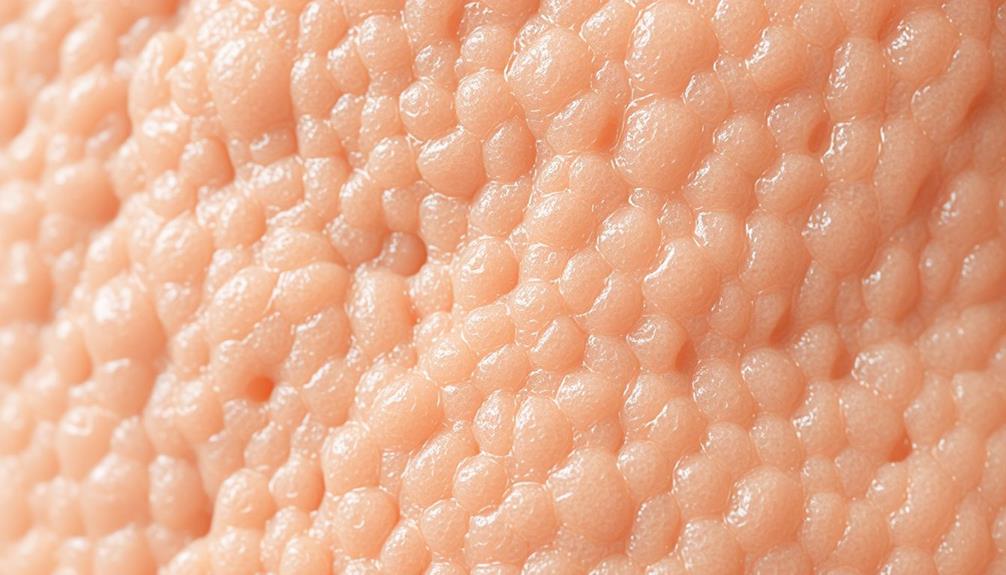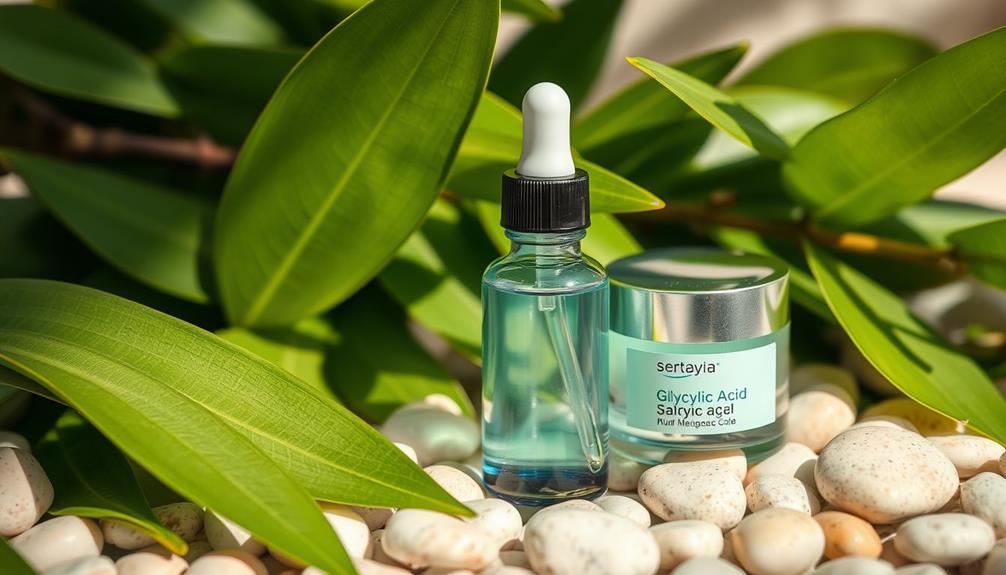Yes, glycolic acid has the potential to reduce the appearance of your pores. This potent exfoliant eliminates dead skin cells, assisting in unclogging pores and averting oil buildup. Professionals concur that regular usage enhances collagen production, resulting in firmer skin and less noticeable pores. Research indicates that consistent application of glycolic acid can produce visible enhancements in as little as four weeks. Dermatologists suggest including glycolic acid in your skincare regimen for its established advantages in improving texture and shrinking pores. There is a myriad of information to explore about maximizing its effects for your skin.
Key Takeaways
- Glycolic acid is an effective exfoliant that removes dead skin cells, unclogging pores and minimizing their appearance.
- Regular use of glycolic acid stimulates collagen production, which firms skin and reduces visibility of enlarged pores.
- Clinical studies show noticeable improvements in pore size and skin texture within four weeks of consistent glycolic acid application.
- Dermatologists recommend incorporating glycolic acid into skincare routines for enhanced skin health and reduced pore size.
Glycolic Acid Explained

Glycolic acid is a powerful exfoliant that helps your skin shed dead cells, making it smoother and reducing the appearance of pores. As an alpha-hydroxy acid (AHA), it effectively exfoliates the skin by breaking down the bonds between dead skin cells. This guarantees easier removal and promotes a clearer complexion.
By regularly incorporating glycolic acid into your skincare routine, you can greatly reduce pore size and improve your skin's overall texture. Additionally, using natural products such as essential oils for skin care can complement the effects of glycolic acid by providing nourishment and promoting overall skin health.
Not only does glycolic acid exfoliate the skin, but it also stimulates collagen production. This is vital for firming the skin and preventing pores from stretching, which contributes to the appearance of enlarged pores. If you're concerned about clogged pores, glycolic acid can help cleanse them by removing trapped dead skin cells, oil, and dirt buildup.
One of the best features of glycolic acid is its suitability for various skin types, including sensitive skin. It's often found in combination products aimed at acne-prone individuals, making it a versatile choice for anyone looking to enhance their skincare regimen.
With consistent use, you'll likely notice a notable improvement in your skin's clarity and firmness.
Scientific Evidence on Pore Size

Research has consistently shown that regular use of glycolic acid can effectively shrink the appearance of pores, enhancing your skin's overall texture. By incorporating glycolic acid into your skincare routine, you can take advantage of its powerful exfoliating properties, which help to unclog pores and reduce pore size over time.
Here's a quick overview of how glycolic acid works:
| Effect | Mechanism | Result |
|---|---|---|
| Exfoliation | Removes dead skin cells | Unclogs pores |
| Collagen Production | Stimulates collagen synthesis | Firms skin, minimizes size of enlarged pores |
| Acne Control | Combines with salicylic acid | Addresses acne and pore size issues |
Clinical studies support these claims, with one showing a 10% glycolic acid formulation can lead to visible results within four weeks. Additionally, research indicates that 71% of women aged 20-35 feel more confident with less noticeable pores, underscoring the psychological benefits of effective treatments like glycolic acid. Embracing glycolic acid in your routine could be the key to achieving smoother, clearer skin.
Expert Opinions on Efficacy

When it comes to the effectiveness of glycolic acid, expert opinions back its use for reducing pore size.
Dermatologists highlight its ability to gently exfoliate and improve skin texture, making it a go-to recommendation.
Incorporating regular skincare routines that include mindful eating and hydration can further enhance skin health.
You'll find that clinical studies consistently support these claims, showcasing significant benefits for your skin.
Clinical Study Findings
Numerous clinical studies have shown that glycolic acid effectively reduces the appearance of enlarged pores and improves skin texture over time.
For instance, a study published in the Journal of Cosmetic Dermatology revealed that a 10% glycolic acid treatment led to a noticeable reduction in pore size within just four weeks of consistent use.
Additionally, research in the Journal of the American Academy of Dermatology highlighted the effectiveness of combining glycolic acid with salicylic acid, especially for those with acne-prone skin, addressing both pore size and acne simultaneously.
Incorporating regular exfoliation into your skincare routine is essential, as it mirrors the importance of regular vet check-ups for monitoring a cat's health.
Dermatologists consistently endorse glycolic acid for its ability to enhance skin texture while minimizing the appearance of enlarged pores.
Dr. Ava Shamban emphasizes the importance of exfoliation, which glycolic acid facilitates by removing dead skin cells that often clog pores and contribute to their enlargement.
Regular use of glycolic acid-based products can lead to significant long-term improvements in pore appearance and overall skin health.
Dermatologist Recommendations
Many dermatologists recommend glycolic acid for its proven efficacy in reducing the appearance of enlarged pores and enhancing overall skin texture.
This powerful exfoliant works by dissolving dead skin cells, which helps prevent clogged pores. Additionally, incorporating gentle yoga stretches into your routine can promote relaxation, further benefiting skin health by reducing stress-related skin issues.
Dr. Ava Shamban emphasizes that by keeping your skin clear of buildup, glycolic acid not only improves the look of your pores but also promotes healthier skin overall.
Clinical studies support these claims, showing that consistent use of a 10% glycolic acid formulation can reduce pore size in as little as four weeks.
Experts like Dr. Rachel Nazarian highlight glycolic acid's gentle nature, making it suitable for various skin types without causing irritation. Regular use can boost collagen production, further improving skin elasticity and texture.
To achieve the best results, dermatologists recommend incorporating glycolic acid into your skincare routine gradually. Start with a lower concentration and increase as your skin adjusts.
By following these dermatologist recommendations, you can effectively tackle enlarged pores while reaping the benefits of smoother, clearer skin.
Embrace glycolic acid as a key component in your journey to enhanced skin health and appearance.
Recommended Glycolic Acid Products

Here are some key benefits of using glycolic acid products:
- Exfoliating properties: They gently remove dead skin cells, promoting cell turnover for a fresh complexion. Understanding the importance of <a target="_blank" href="https://howlingwolfherbs.com">sustainable harvesting methods</a> can enhance your approach to skincare ingredients.
- Minimize their appearance: Regular use can considerably reduce pore size, making them less noticeable.
- Enhanced skin texture: You'll likely notice a smoother, more even skin surface over time.
Importance of Pore Refinement

Pore refinement plays a significant role in boosting your confidence and enhancing your overall appearance.
Smaller pores often give off a more youthful vibe, making you feel better about how you look.
Additionally, practices like self-exploration through body awareness can contribute to a more positive self-image.
Plus, the psychological impact of having smoother skin can elevate your mood and self-esteem.
Confidence With Smaller Pores
Feeling more confident often comes from having smoother skin with less noticeable pores, a desire echoed by many in today's beauty standards. When you achieve smaller pores, it can greatly boost your self-esteem and change how you perceive yourself.
Here's how pore refinement can impact your confidence:
- You might notice a smoother skin texture, making makeup application easier and more flawless.
- Smaller pores can enhance your overall appearance, giving you a fresh, polished look.
- The psychological impact of reduced visibility of enlarged pores can lead to greater self-assurance in social situations.
Clinical evidence shows that products containing glycolic acid effectively refine pores, making them less noticeable. As dermatologists endorse this treatment, you're not just improving your skin's appearance—you're actively working on boosting your confidence.
With each use, you're on your way to achieving that smoother, clearer complexion. Embrace the process and enjoy the benefits of feeling more confident in your skin!
Youthful Appearance Benefits
Achieving smaller pores not only boosts your confidence but also plays a key role in enhancing your youthful appearance. Many women believe that reducing pore size contributes considerably to looking younger, and studies show they're right.
Consistent use of glycolic acid can visibly improve skin texture while minimizing the appearance of pores. This powerful ingredient works by exfoliating dead skin cells, allowing fresh skin to emerge, which ultimately leads to enhanced pore refinement.
Moreover, glycolic acid stimulates collagen production, helping to firm your skin and further reduce the visibility of enlarged pores. As you use glycolic acid, you'll notice a smoother skin texture that reinforces the perception of youthfulness.
Dermatologists have found that minimizing the appearance of pores is a major concern for many, especially women aged 20-35. By incorporating glycolic acid into your skincare routine, you can achieve not just a beautiful complexion but a more youthful look overall.
Psychological Impact of Pores
The appearance of enlarged pores can greatly impact your self-esteem, making pore refinement an essential aspect of many people's skincare journeys.
A study by SK-II revealed that a significant number of American women feel more confident with less noticeable pores. The psychological impact of pore visibility can often lead to feelings of inadequacy, pushing individuals to seek effective skincare solutions.
Consider the benefits of achieving smaller pores:
- Enhanced self-esteem as you embrace your natural beauty
- A more youthful appearance that reflects energy and health
- Increased confidence in social situations, allowing you to shine
With 74% of participants believing that smaller pores contribute to beauty, it's clear that pore refinement is more than just a cosmetic choice.
It's about feeling good in your skin and improving your mental well-being. The obsession with pore size, sometimes termed "porexia," underscores the need for effective skincare solutions like glycolic acid.
Understanding Pore Structure

Understanding the structure of pores reveals how they function as vital pathways for sweat and oil, important for maintaining healthy skin.
Pores are tiny openings in your skin, averaging around 20,000 on your face alone. They're especially concentrated on areas like your nose and forehead, where sebaceous glands produce oil. The size of your pores is largely influenced by genetics, with oily skin types typically having larger pores due to excess sebum production.
As you age, your skin experiences a loss of collagen and elastin, which can cause your pores to appear larger. This is why maintaining skin health is significant—not just for appearance but for function.
While you can't change the permanent nature of pores, you can work to reduce their appearance through informed skincare choices.
Glycolic acid is one ingredient that can help in this regard. By promoting skin cell turnover and improving overall texture, it may enhance the appearance of your pores.
However, understanding pore structure is the first step in addressing any concerns. With the right approach, you can help your skin look its best while ensuring that your pores continue to function effectively.
Benefits of Glycolic Acid

Glycolic acid offers impressive benefits for your skin, primarily through its exfoliating properties that promote skin renewal.
By breaking down dead skin cells, it not only smooths your skin texture but also enhances collagen production, helping to keep your pores looking tight.
Incorporating glycolic acid into your routine can lead to a healthier, more radiant complexion.
Exfoliation and Skin Renewal
Exfoliating with glycolic acid effectively removes dead skin cells, paving the way for smoother, more radiant skin. By breaking down the bonds between those dead cells, glycolic acid enhances skin renewal and improves overall skin texture. You'll notice significant benefits, especially if you have acne-prone skin or enlarged pores.
Here's what you can expect from regular glycolic acid use:
- Reduced pore size: Consistent exfoliation helps minimize the appearance of pores.
- Smoother skin texture: Say goodbye to rough patches and hello to a refined complexion.
- Fewer breakouts: By unclogging pores and removing oil and dirt, glycolic acid helps prevent blemishes.
Dermatologists recommend incorporating glycolic acid into your skincare routine for its gentle yet powerful effects. As it promotes exfoliation and skin renewal, you'll enjoy a clearer complexion and a boost in confidence.
Whether you're dealing with enlarged pores or uneven skin, glycolic acid is a fantastic solution that can help you achieve the skin you've always wanted.
Collagen Production Enhancement
By boosting collagen production, glycolic acid not only enhances skin elasticity and firmness but also helps reduce the appearance of enlarged pores.
When you incorporate glycolic acid into your skincare routine, you're actively stimulating collagen synthesis, which is essential for maintaining a smooth and youthful skin texture.
Dermatologists often recommend glycolic acid because it's shown to be more effective in enhancing collagen levels compared to other acids.
This increase in collagen helps prevent pores from stretching, ultimately reducing the size of large pores over time.
As you regularly use glycolic acid-based products, you can expect visible improvements in both your skin texture and the overall appearance of your pores within just a few weeks.
Managing Enlarged Pores

Managing enlarged pores effectively involves incorporating glycolic acid into your skincare routine, as it helps to unclog pores and promote cell turnover. By using glycolic acid regularly, you can reduce the appearance of enlarged pores and enjoy clearer skin. Here's how it works:
- Exfoliation: Glycolic acid promotes regular exfoliation, removing dead skin cells that contribute to pore size.
- Collagen Production: It stimulates collagen production, improving skin texture over time.
- Oil Control: Regular use prevents the buildup of oil and dirt in pores, minimizing their visibility.
As you integrate glycolic acid into your skincare routine, you'll notice a smoother complexion and reduced pore size. Dermatologists recommend it as a safe and effective option for all skin types.
Skincare Routine Tips

To achieve the best results in reducing the appearance of enlarged pores, it's important to establish a consistent skincare routine tailored to your skin's needs.
Start by using a gentle cleanser twice daily to remove excess oil and dirt, which can help minimize pores.
Regularly exfoliate 2-3 times a week with products containing glycolic acid or other AHAs; this promotes skin cell turnover and prevents clogged pores.
Incorporate a lightweight, non-comedogenic moisturizer to keep your skin hydrated without blocking pores.
After cleansing, using toners with astringent properties can help balance your skin's pH and tighten pores, enhancing the overall appearance.
Make sure to apply a broad-spectrum sunscreen every day to protect collagen and elastin, which are essential for maintaining skin structure and preventing pore enlargement over time.
Treatments for Pore Minimization

Exploring glycolic acid treatments can greatly enhance your efforts in minimizing the appearance of enlarged pores. These treatments work by exfoliating the skin and stimulating collagen production, which helps reduce pore size and improve your overall skin texture.
Here are some effective options to evaluate:
- Over-the-Counter Glycolic Acid Products: Look for lotions and gels that you can use daily.
- Professional Chemical Peels: These treatments, performed by dermatologists, can provide more dramatic results.
- Combining Ingredients: Pair glycolic acid with salicylic acid for enhanced effects, especially if you have acne-prone skin.
Regular use of these treatments can lead to visible improvements in just a few weeks. By incorporating glycolic acid into your skincare routine, you'll not only tackle enlarged pores but also promote firmer, smoother skin.
Whether you're opting for at-home solutions or professional help, the journey to refined pores starts with the right glycolic acid treatment.
Frequently Asked Questions
Does Glycolic Acid Reduce Pore Size?
Yes, glycolic acid reduces pore size by exfoliating dead skin cells and promoting collagen production. With regular use, you'll notice unclogged pores and improved skin texture, making it an effective addition to your skincare routine.
Do Dermatologists Recommend Glycolic Acid?
Yes, dermatologists often recommend glycolic acid for its effectiveness in improving skin texture and reducing the appearance of pores. Its gentle exfoliation helps prevent clogged pores, making it a suitable choice for various skin types.
Which Acid Is Best for Shrinking Pores?
When it comes to shrinking pores, glycolic acid is often your best bet due to its exfoliating properties. Salicylic acid can also help, especially for oily skin. Consider trying both for ideal results.
What Is the Most Effective Pore Minimizer?
To effectively minimize pores, you should consider ingredients like glycolic acid, salicylic acid, or retinoids. These help exfoliate, unclog, and tighten your skin, giving you a smoother, more refined complexion over time.
Conclusion
So, can glycolic acid really shrink pores?
While it may not literally reduce their size, it can help improve skin texture and clarity, making pores appear less noticeable.
Think of it as a gentle exfoliation that keeps your skin smooth and radiant.
Combine it with a solid skincare routine and you'll likely see a difference over time.
Embrace the journey to healthier skin—your pores just might thank you for it!










